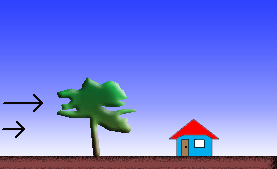

Building and environment
The construction of a new building influences its environment: The site has to be developed, ground is sealed, access roads and parking areas are needed and so forth. On the other hand, the environment affects a building. If, e.g. a house is built on the slope of a mountain, one side of the house will gain very few daylight. The utilizations of the different rooms have to be planned accordingly.
Site integration of buildings
Two different kinds to integrate a building into its site (topography, nature) can be distinguished: by harmonising and assimilating or by dominant architecture [1].
In the first case, buildings are integrated rather inconspicuously into nature and landscape. The architecture considers the forms, colours and dimensions of the surroundings. The prevailing flora and fauna of the site is regarded for building design and material selection. Thereby, e.g. by local particularities of the topography, the possibilities for building design are restricted and can be quite limited. For the second case, dominant architecture considers buildings as distinct landmark. They can be intentionally in contrast to their surroundings.
Sun and wind as microclimatic factors can significantly influence the energy balance of a building. Generally, wind-exposed locations or such in a flat plane lead to greater air-change-rates and, therefore, to higher ventilation losses (see figure 1) than sheltered locations in valleys. However, in these positions less solar gains are available (see figure 2).
 |
 |
|
| Figure 1: Flat plane | Figure 2: Sheltered location |
The environment of a building does not only consist of its natural topography, like hills, wood, waters and undeveloped area but also of the surrounding buildings and streets. For example a dense development in a city centre results in a larger outside temperature than for rural areas in which the densities of building are not so high. In urban areas with a high building density, and with high rise buildings or skyscrapers, the incident sunlight is several times reflected at the building facades before it is finally absorbed or reaches the ground. Therefore, the released heat power to the surroundings is there larger than in a flat rural environment with less opportunities for absorption. Besides that, in urban areas there exists a higher thermal mass to store up heat. Measurements have shown, that the temperature over a surface of stones can be up to 8°C higher than over a meadow [2]. So, when planning towns or cities with high rise buildings, larger apartment blocks or greater housing density, attention must be paid on the availability of enough green spaces. Moreover, building aerodynamics has to be considered. The orientation of the buildings must take into account the predominant direction of the wind, so that the air flow between the buildings is not prevented. By that, too high pollution levels e.g. due to sources of exhaust gas can be avoided. Simultaneously one has to take care that no strong draughts ("wind tunnels", Venturi flows) can develop.
Consumption of land and demand of material
'Consumption of land' is defined as the conversion of nature into cultivated area, whereby cultivated area mean land which is influenced by human beings. For example, the percentage of ground being used for settlement and traffic for example in Germany is about 12 % of the total ground area (see figure 3).
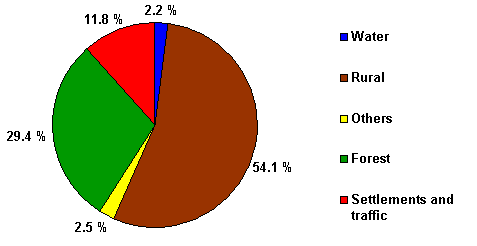 |
| Figure 3: Utilization of area in Germany 1997 [3] |
The demand for living space per person in Germany is increasing steadily, whereby especially the percentage of single households is constantly growing (see figure 4). In Germany, the average number of persons per household is about 2.2. The average living space per person amounts to 39.3 m² [4]. These development leads to the circumstances, that always more living space is needed and created. Everyday about 120 hectares of agricultural and forest area is converted into housing estates or areas of industry, business and traffic [5].
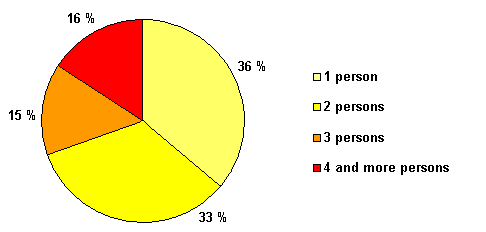 |
| Figure 4: Number of persons per household in Germany |
Living space can be divided into urban and rural regions. In rural areas single, double and terraced houses predominate, mostly having one or two floors. They show a high specific demand for land being converted into living space and hence a relative high amount of land is sealed per person.
Judged by the consumption of land per head urban areas are more economic due to the multi-storey-apartments and multi-family-houses. To reduce the consumption per m² compared to single or double houses, living space is closely packed together and pilled on the top of each other and furthermore less streets are needed to access such areas A measure for the density of population is the floor space index. This is the ratio between the total area of all storeys of a house and the area of the premise. In rural regions, the floor space index is about 0.3 or even less. In regions with a high density of buildings one can find a floor space index of 2 or even above. To limitate the consumption of land the floor space index of new residential areas should be about 0.8 [6].
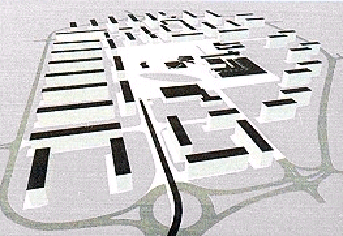 |
| Figure 5: Typical settlement with blocks of flats |
When constructing a building, the building is mainly taken from nature (Cement, concrete, stones, wood, schist, etc.), whereby the building leaves an "ecological footprint". Rock quarries, factories for cement and gravel, sawmills etc. provide the different building materials. E.g. in Germany altogether about 8.5 to 9.7 tons of mineral construction materials are used per year and person. This amounts to about 700 - 800 million tons per year [3]. To keep the negative influences to the environment as slight as possible, the former mining areas have to be renaturalized. The total demand of mineral construction material (Germany) can be estimated to about 50 billion tons, resp. 600 tons per inhabitant.
Every year about 80 million tons of rubbish accrue by demolition and rehabilitation, (ca. 1 ton per inhabitant, see figure 6), which are dumped at landfills and repositories or are stored for recycling. At the moment the percentage of recycling is about 70% [3]. In addition, there is also the dumping and the recycling of excavated soil, road surface and construction waste.
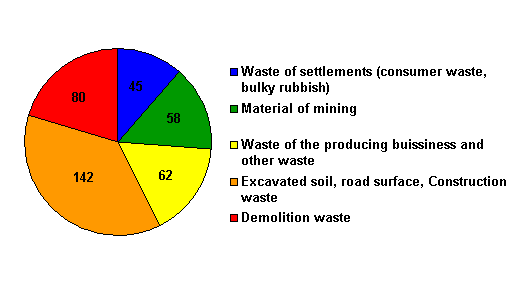 |
| Figure 6: Amount of waste in Germany 1997 (in millions of tons) |
Road construction / traffic
There are different kinds of traffic in more rural or pure urban regions. In rural areas on the one hand the density of traffic is not so high due to the less population density, but on the other hand more streets are needed for the access of residential areas as well as for their connection. Here the main means of transportation are cars.
Inside bigger cities and settlements often an attractive public transport system exists, so that the need of a car may be of less importance. In car-free zones, cars can be left at parking areas at the rims of the settlements. The road access to the buildings is only planed for delivery and collection purposes. To achieve this asphalted streets between the blocks of flats and parking areas in the courtyards are not needed. Instead, small streets reduced from traffic are connecting the buildings, leaving space for bushes, shrubs and trees in the rim.
Sealing of ground / microclimate
The increasing sealing of the earth's surface has different consequences. First, the altered draining and trickling away of rain water. On undisturbed area covered with vegetation, the percentage of the rainwater draining off at the surface is 0 to 20%. At slightly compacted resp. paved planes 60% and on roofs, bituminised or concreted areas, 80% to 100% of the rain water drains off at the surface [7]. This causes small rivers to swell soonly after a heavy rain. Longer periods of rain will lead to an increase of the water level also of bigger streams and in the end to floods. Furthermore, the rapidly draining off on the surface leads to increased erosion.
The amount of rainwater draining off above-ground depends partly on the location, the texture and the decent of the different surfaces. A noticeable effect on the retentioning of rain water can already be reached by a frequent change small sealed and non-sealed areas. On the sealed areas, the water drains off towards the non-sealed areas, where it partly trickles away.
Large areas where no water trickles away into the soil can lead to a dry surface with an unhealthy microclimate (city climate) during times with no or low precipitation. The air is very dusty. At calm days this can form a blanket of smog over a city or a region together with the exhaust gas e.g. by traffic and other pollution burdens.
The influence of development and sealing critically influences the microclimate in larger residential areas and inside of cities. In rural regions is mostly enough open and green areas and forests exists to maintain a pleasant microclimate. At a nice summer day, a fully grown deciduous tree e.g. a beech, lime or birch, can evaporate up to 500 litres of water through its about 200,000 leafs [5]. That means, it evaporates every 100 days the amount of water which is consumed by a human being during the whole life (70 years, 2 litres/day).
However, inside of towns a dry polluted microclimate easily develops. Above asphalt and at building structures e.g. the air humidity is in general under 55 % [2], i.e. it is only determined by the content of water vapour of the meteorological air flow. On the other hand, above larger lawn areas it comes up to roughly 90%. The reason for this is the accumulation of water vapour in the air because of the evaporation at the ground's surface. Instead of completely asphalting ways and spaces, e.g. grass pavers should be used. These reduce the part of the sealed area. Water can penetrate into the earth and can again evaporate or serve trees and other vegetation as base for living (see figure 7). Furthermore, green areas with trees and bushes absorb during a period of fine weather up to one quarter more of radiation than a plane meadow. Through this means a dry, resting air can be avoided.
 |
| Figure 7: Grass pavers |
So, the creation of 'green islands' between residential buildings or inside of courtyards helps to improve the microclimate. Not to forget is the effect it has on the human's wellness. Little green "oasis" in combination with e.g. children's playgrounds, seats etc. can convert a plain courtyard into an attractive room for recreation and meeting together.
During the whole lifespan of a building - from the contraction up to demolition - and even after that, the environment is being influenced. Because of the increasing population density with the tendency to ever more buildings, architecture and town planning have to pay attention along with their main aim - the creation of pleasant living area for people - to make these influences as slight as possible. These concern aspects like consumption of land, demand of materials, traffic, sealing of ground, flood protection as well as the urban microclimate.
Literatur / Links:
[1] "ISIS Architektur" - Herausgegeben vom Fachgebiet Bauphysik & Solarenergie, Universität Siegen, Ltg.: Prof. F.D. Heidt, 2002, http://nesa1.uni-siegen.de/.
[2] "Fibel zum Landschaftsverbrauch: Schritte zur Verringerung des Verbrauchs im Siedlungsbereich" - Herausgeber: Landesanstalt für Umweltschutz (LfU) Baden-Württemberg, Institut für Ökologie und Naturschutz, Karlsruhe, im Auftrag des: Ministeriums für Umwelt Baden-Württemberg 1988, http://www.uvm.baden-wuerttemberg.de/nafaweb/berichte/plp_03/fib.htm.
[3] "Daten zur Umwelt 200" - Umweltbundesamt der Bundesrepublik Deutschland, http://www.umweltbundesamt.de/
[4] "Bauen und Wohnen" - Statistisches Bundesamt Deutschland, http://www.destatis.de/
[5] "Flächenverbrauch und Wiedernutzung von Brachflächen" - Herausgegeben vom Institut für Landes- und Stadtentwicklung der Landes Nordrhein-Westfalen (ILS) im Auftrag des Ministers für Landes- und Stadtentwicklung - waz-druck Vertrieb und Verlag, Duisburg, 1984.
[6] Enquete-Kommission des Deutschen Bundestags - "Schutz des Menschen und der Umwelt" - 1997.
[7] W. Geiger, H. Dreiseitl - "Neue Wege für das Regenwasser: Handbuch zum Rückhalt und zur Versickerung von Regenwasser in Baugebieten" - R. Oldenbourg Verlag GmbH, München, 1995, ISBN 348626259-9.